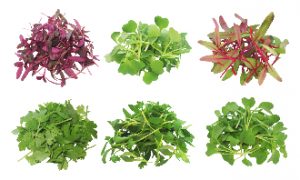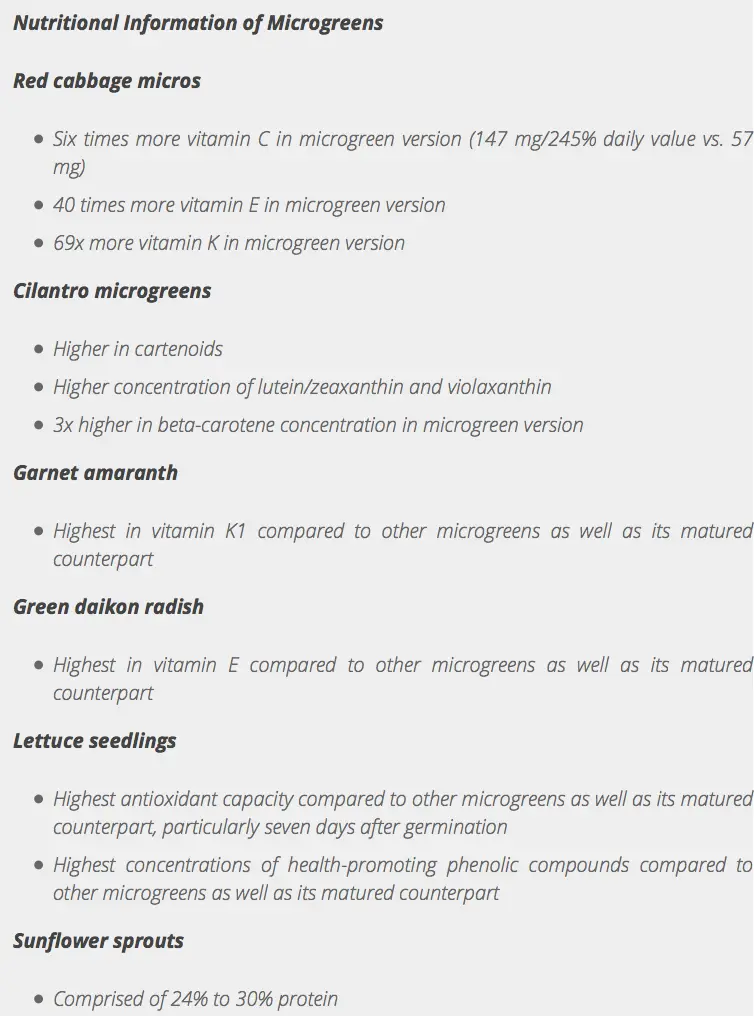I love to garden. It helps me be mindful of the world around me. And it lets me interact and teach lessons to my children (my son looks like he’ll be a right little Mr. Green Thumbs!). I think gardening is the best way to explain the circle of life, and reminds me that there are bigger things in this world.
But I live in the northern half of the country, and winter comes and I get stuck inside with no gardening to do. Until my husband suggested that I start an indoor garden (this was a few years ago). But what did I want to grow? I had potted plants around the house, tropical ones that throw out flowers all year round. But I wanted to grow something practical.
I started growing herbs that first year, and then in the second I started growing microgreens.
What Are Microgreens?

Microgreens are the baby plant. They can be grown year-round, are suitable for raw food diets, contain few carbohydrates, and have enough of their own flavors that they do not need added sugar, salt and oil to make them interesting. They brighten up salads and ‘slaws. They make a wonderful garnish and you can slip them into healthy baking (in small amounts) to boost nutritional value.
Essentially, microgreens are young seedlings of edible vegetables and herbs harvested less than 14 days after germination.
Okay… But What’s So Great About Them?
Microgreens are essentially all of a big leaf condensed into a really small leaf. Before the leaves get too big and the plant needs them for itself, all those nutrients are hanging out in a much smaller package. A study in 2012 showed that microgreens can be 4 to 40 times more potent than their bigger counterparts,
The microgreens were four- to 40-fold more concentrated with nutrients than their mature counterparts,” says researcher Qin Wang, PhD, assistant professor at the University of Maryland in College Park. “When we first got the results we had to rush to double and triple check them.”
Check out this chart:

You’ll notice that there are a lot of antioxidants mentioned in that chart, form Vitamin A to Vitamin B. Look at all the vitamins! Guess what these are good for? They all link to a reduced likelihood of cancer.
“All of these nutrients are extremely important for skin, eyes, and have all sorts of benefits associated with them,” says researcher Gene Lester, PhD, of the USDA.
How To Grow Them

So I sold you on microgreens and now you want me to tell you how to grow them. There are a lot of a great resources out there. But the one I use is this.
Things you Need:
- 3-inch peat pots or other suitable containers
- Soil-less seed-starting mix (it can be a bit tricky to find, but with summer coming, garden stores should start carrying it again)
- Vermiculite (a mineral compound that absorbs water and then slowly releases it back in to the plant.)
- Seeds (take your pick from those above)
- Plant labels
- Plastic wrap
Steps:
- Put your soil-less seed starter in a bucket. Moisten the soilless seed-starting mix, by sprinkling warm water onto the mix and blend until it is thoroughly damp.
- Put your mix inside your peat pots, don’t pack it down, fill to within 1.5″ of the top. Put these in a “drip proof” tray (water tight)
- Sprinkle your seeds on top of the soil. You can plant these much more tightly than regular seeds, but leave a little room.
- Cover your seeds with vermiculite. Read each seeds package carefully for depth of planting requirement. Place that much vermiculite on your seeds.
- Water gently. Don’t drown anyone! Too much water means they won’t put out seeds and then you’ll get nothing.
- Cover these bad boys with cling film/plastic wrap/cellophane (whatever you call it)
- If you can find one, use a seedling heat pad to encourage growth.
- When you have 1/2″ of growth, remove your cling film cover and then place them in a sunny place. Water them by filling the tray instead of pouring water on top of them.
- Harvest between 7-14 days.
Sources
http://www.ncbi.nlm.nih.gov/pubmed/26857557
http://www.tandfonline.com/doi/abs/10.1080/10408398.2016.1144557?journalCode=bfsn20
http://www.webmd.com/diet/20120831/tiny-microgreens-packed-nutrients


